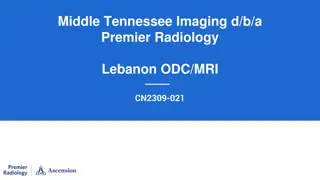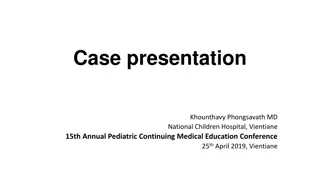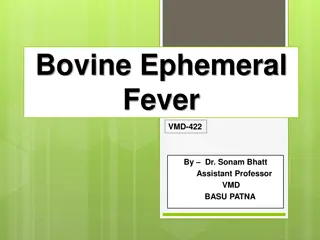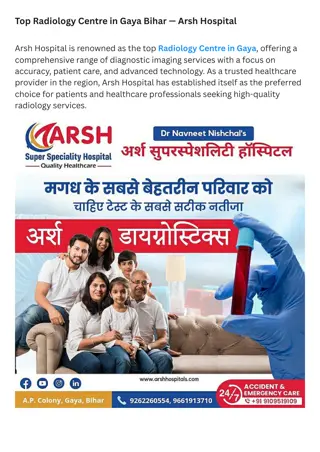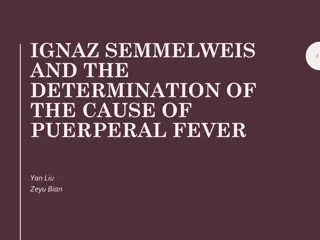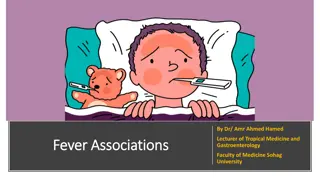Radiology Case Presentation: Rocky Mountain Spotted Fever in a Young Female
A 34-year-old female with malaise, altered mental status, and thrombocytopenia was diagnosed with Rocky Mountain Spotted Fever after presenting with headache, chills, and somnolence following a trip to a wooded area. Despite initial puzzling symptoms and negative tickborne antibody tests, she showed clinical improvement after initiating doxycycline, supporting the diagnosis. Radiographic features included ground-glass opacities and interlobular septal thickening. Discharged with slight headache, subsequent titers showed elevated RMSF IgM and IgG levels, confirming the diagnosis.
Download Presentation

Please find below an Image/Link to download the presentation.
The content on the website is provided AS IS for your information and personal use only. It may not be sold, licensed, or shared on other websites without obtaining consent from the author. Download presentation by click this link. If you encounter any issues during the download, it is possible that the publisher has removed the file from their server.
E N D
Presentation Transcript
Radiology Case Presentation Sami Natour, MS4 UVA School of Medicine
Clinical History E.R. is a 34 year old female with a past medical history of ADHD who was transferred from an OSH with malaise, altered mental status, and thrombocytopenia Was recently in North Carolina for funeral where she was in heavily wooded area. Returned ~1 week ago. On ride home, developed headache, chills, and somnolence In days leading up to UVA admission: - Urgent care clinic suspected herpes zoster; Acyclovir reportedly worsened her symptoms - Presented twice to OSH after developing N/V. On second admission, found to be febrile and hypotensive to 79/40 Other notable labs: PLT 36,000, AST/ALT/ALP 50/58/137 Started on empiric vancomycin, ceftriaxone, and solumedrol
Notable Physical Exam Findings, Labs Gen: Patient sleeping and falling asleep in middle of interview and exam but easily aroused Neck: No meningismus, PERRL Cardio: RRR, no murmurs Pulm: Coarse breath sounds bilaterally with bibasilar crackles; on 2L NC Skin: Violaceous mottling over bilateral upper and lower extremities Heme: No petechiae or ecchymosis appreciated Neuro: AOx4 when aroused WBC: 8.48 Hgb: 11.7 (L) PLT: 32 (L) AST: 38 (H) ALT: 21 ALP: 108 T Bili: 0.5
Imaging Studies ordered at OSH (UVA overread) - CT Head (No acute intracranial abnormality) - US Gallbladder (Unremarkable) CTPA ordered due to elevated D-Dimer (see following slide)
Hospital Course Admitted to ICU and treated with vancomycin, ceftriaxone, and doxycycline. Extensive workup was negative for bacterial endocarditis, bacterial meningitis, autoimmune/vasculitic process, and fungal etiologies Tickborne etiologies explored (RMSF, Ehrlichia, Lyme); antibodies all negative on admission In consultation with ID, Dermatology, and Hematology, diagnosed Rocky Mountain Spotted Fever (supported by clinical improvement after initiating doxycycline) Discharged on HD #6 with slight headache Titers drawn ~2 weeks after presentation showed newly elevated RMSF IgM and IgG
Radiographic features of RMSF 1. Acute ground-glass opacities and interlobular septal thickening - In RMSF, vasculitis causes pulmonary infiltrates in ~1/3 of patients, of which 85% appear interstitial and 15% appear as consolidations - ARDS develops in approx. 7% of patients Differential Diagnosis for GGO: Blood, pus, water, cells Blood: Pulmonary hemorrhage Pus: PCP, Mycoplasma, Viral pneumonia Water: Pulmonary edema (cardiogenic vs non-cardiogenic) Others: Acute interstitial pneumonia, early ILD, HP 2. Scattered nodular opacities, most pronounced in the subpleural upper lobes - Nonspecific: infectious vs. inflammatory
References 1. Faul JL, Doyle RL, Kao PN, Ruoss SJ. Tick-borne pulmonary disease: update on diagnosis and management. Chest. 1999 Jul;116(1):222-30. Review. PubMed PMID: 10424529. 2. Miller WT Jr, Shah RM. Isolated diffuse ground-glass opacity in thoracic CT: causes and clinical presentations. AJR Am J Roentgenol. 2005 Feb;184(2):613-22. Review. PubMed PMID: 15671387. 3. Robert NA. Squire's Fundamentals of Radiology. 6 ed. Cambridge, Massachusetts, and London, England: Harvard University Press; 2004.



